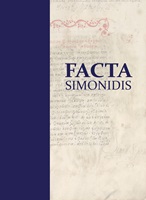Relacje księży Karola Dębińskiego i Feliksa Majewskiego z wizytacji duszpasterskich biskupa lubelskiego Franciszka Jaczewskiego jako źródło do badań architektury sakralnej w diecezji lubelskiej na początku XX wieku
Bishop Franciszek Jaczewski’s Pastoral Visits in the Accounts of Priests Karol Dębiński and Feliks Majewski as a Source for Research on Sacred Architecture in the Lublin Diocese in the Early 20th Century
Author(s): Anna Bartko-MalinowskaSubject(s): History of Church(es), Social history, Pre-WW I & WW I (1900 -1919), Sociology of Religion, History of Religion
Published by: OFFICINA SIMONIDIS. Wydawnictwo Uczelni Państwowej im. Szymona Szymonowica w Zamościu
Keywords: visitation; church; Fr. Karol Dębiński; Bishop Franciszek Jaczewski; Fr. Feliks Majewski; Greek Catholics; sacred architecture; 1905 decree on religious tolerance;
Summary/Abstract: Pastoral visits of parishes, typically conducted on an annual basis, constitute a fundamental duty of Catholic bishops. Such visits serve as occasions for addressing the concerns and needs of the faithful, while also providing an opportunity to assess the state of parish churches. However, the religious policies enforced by the Russian government in the Kingdom of Poland imposed restrictions on the ability of the bishops of Lublin and Siedlce to visit parishes situated in regions inhabited by the Uniate population. The decree on religious tolerance of April 17/30, 1905 enabled former Uniates to return to the Catholic Church and expanded the scope of activities for the Catholic clergy. Bishop Franciszek Jaczewski of the Lublin Diocese promptly availed himself of this newfound opportunity and made the inaugural visit to the the south-eastern part of the Lublin Diocese on May 13 of the same year. In 1905 alone, the bishop visited a total of 56 parishes and continued his visits in 1906 and 1907. The first visit, which was of immense significance, was meticulously documented by Father Karol Dębiński, while the subsequent visit, conducted one year later, was chronicled by Father Feliks Majewski. These accounts provide insights into the historical background of the visited localities, the genesis of the parishes, and the architectural features of the ecclesiastical structures, including their external façades, state of preservation, and interior furnishings. Significantly, these narratives are complemented by rich photographic material. It is worth noting that these accounts often convey the subjective viewpoints and impressions of the authors, which, nevertheless, does not impinge on their informative value. Given the authors’ assiduousness, these reports are an invaluable source for investigating the objects visited by the bishop, especially considering that some have undergone alterations or have not survived till the present day. The meticulous descriptions of the ecclesiastical edifices, offered by first-hand witnesses, are of considerable historiographic significance, particularly for scholars of art history specialising in the sacred architecture of the Lublin region.
Journal: Facta Simonidis
- Issue Year: 16/2023
- Issue No: 1
- Page Range: 237-251
- Page Count: 15
- Language: Polish

